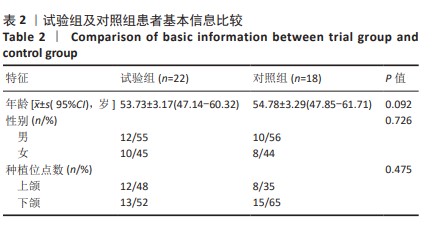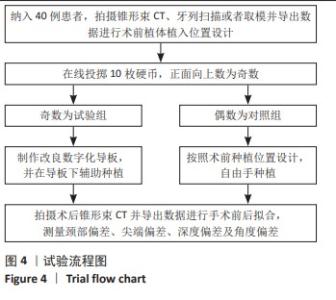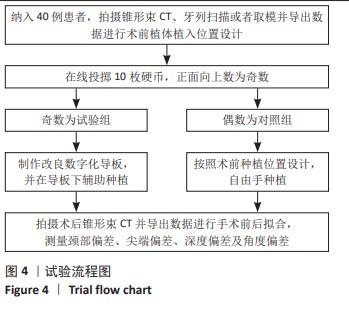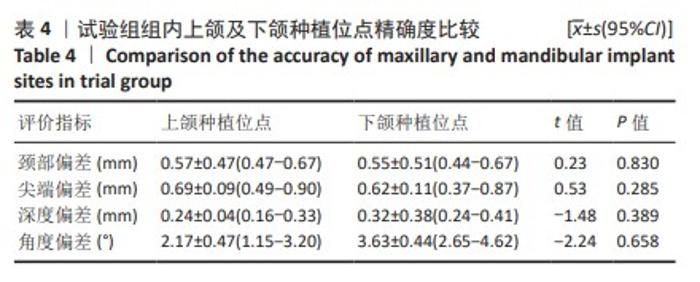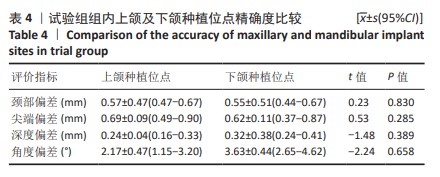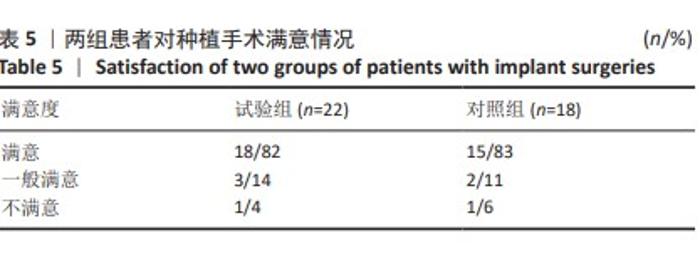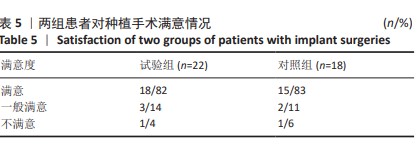[1] RAWAL S. Guided innovations: Robot-assisted dental implant surgery. J Prosthet Dent. 2022;127(5):673-674.
[2] POMARES-PUIG C, SÁNCHEZ-GARCÉS MA, JORBA-GARCÍA A. Dynamic and static computer-assisted implant surgery for completely edentulous patients. A proof of a concept. J Dent. 2023;130:104443.
[3] CHACKARTCHI T, ROMANOS GE, PARKANYI L, et al. Reducing errors in guided implant surgery to optimize treatment outcomes. Periodontol 2000. 2022;88(1):64-72.
[4] KUNAKORNSAWAT W, SERICHETAPHONGSE P, ARUNJAROENSUK S, et al.
Training of novice surgeons using dynamic computer assisted dental implant surgery: An exploratory randomized trial. Clin Implant Dent Relat Res. 2023;25(3):511-518.
[5] TAHMASEB A, WU V, WISMEIJER D, et al. The accuracy of static computer-aided implant surgery: A systematic review and meta-analysis. Clin Oral Implants Res. 2018;29(16):416-435.
[6] SOMOGYI-GANSS E, HOLMES HI, JOKSTAD A. Accuracy of a novel prototype dynamic computer-assisted surgery system. Clin Oral Implants Res. 2015;26(8):882-890.
[7] ASHY LM. Restoration-type Outcome of Freehand Implant Placement in Single Edentulous Gaps: An Observational Study. J Contemp Dent Pract. 2019;20(11):1274-1278.
[8] JAEMSUWAN S, ARUNJAROENSUK S, KABOOSAYA B, et al. Comparison of the accuracy of implant position among freehand implant placement, static and dynamic computer-assisted implant surgery in fully edentulous patients: a non-randomized prospective study. Int J Oral Maxillofac Surg. 2023;52(2):264-271.
[9] HUANG L, LIU L, YANG S, et al. Evaluation of the accuracy of implant placement by using implant positional guide versus freehand: a prospective clinical study. Int J Implant Dent. 2023;9(1):45.
[10] SCHERER U, STOETZER M, RUECKER M, et al. Template-guided vs. non-guided drilling in site preparation of dental implants. Clin Oral Investig. 2015;19(6):1339-1346.
[11] POMARES-PUIG C, SÁNCHEZ-GARCÉS MA, JORBA-GARCÍA A. Dynamic and static computer-guided surgery using the double-factor technique for completely edentulous patients: A dental technique. J Prosthet Dent. 2022;128(5):852-857.
[12] STÜNKEL R, ZELLER AN, BOHNE T, et al. Accuracy of intraoral real-time navigation versus static, CAD/CAM-manufactured pilot drilling guides in dental implant surgery: an in vitro study. Int J Implant Dent. 2022;8(1):41.
[13] 陈婷.种植外科导板临床应用及改良的研究进展[J].中华口腔医学研究杂志(电子版),2019,13(6):376-380.
[14] 林周兴,高跃,张晓蕾,等.自主式口腔种植机器人模型实验的精度分析[J].实用口腔医学杂志,2023,39(4):426-432.
[15] PIMKHAOKHAM A, JIARANUCHART S, KABOOSAYA B, et al. Can computer-assisted implant surgery improve clinical outcomes and reduce the frequency and intensity of complications in implant dentistry? A critical review. Periodontol 2000. 2022;90(1):197-223.
[16] 张思慧,陈威夷,蔡琴,等.比较全程引导与半程引导机器人技术对无牙颌种植精度的影响[J].中国口腔种植学杂志,2023,28(4): 229-232.
[17] 陈江,宿玉成,沈国芳,等.口腔种植机器人临床应用的专家共识(第一版)[J].中国口腔种植学杂志,2023,28(3):134-139.
[18] JORBA-GARCÍA A, GONZÁLEZ-BARNADAS A, CAMPS-FONT O, et al.
Accuracy assessment of dynamic computer-aided implant placement: a systematic review and meta-analysis. Clin Oral Investig. 2021;25(5): 2479-2494.
[19] 满毅,杨幕童.种植机器人、动态导航及全程导板在口腔种植领域的临床应用进展[J].中国口腔种植学杂志,2023,28(3):146-151.
[20] ROMANDINI M, RUALES-CARRERA E, SADILINA S, et al. Minimal invasiveness at dental implant placement: A systematic review with meta-analyses on flapless fully guided surgery. Periodontol 2000. 2023;91(1):89-112.
[21] PESSOA R, SIQUEIRA R, LI J, et al. The Impact of Surgical Guide Fixation and Implant Location on Accuracy of Static Computer-Assisted Implant Surgery. J Prosthodont. 2022;31(2):155-164.
[22] YU X, TAO B, WANG F, et al. Accuracy assessment of dynamic navigation during implant placement: A systematic review and meta-analysis of clinical studies in the last 10 years. J Dent. 2023;135:104567.
[23] YOTPIBULWONG T, ARUNJAROENSUK S, KABOOSAYA B, et al. Accuracy of implant placement with a combined use of static and dynamic computer-assisted implant surgery in single tooth space: A randomized controlled trial. Clin Oral Implants Res. 2023;34(4):330-341.
[24] BARRAK IÁ, VARGA E, PIFFKO J. Navigation in implantology: Accuracy assessment regarding the literature. Fogorv Sz. 2016;109(2):61-68.
[25] 骆泯润,白雪莹,祝雨茜,等.无牙颌金属种植导板精度分析的病例系列[J].中国口腔种植学杂志,2023,28(4):223-228.
[26] GOLDSTEIN G, GOODACRE C, MACGREGOR K. Occlusal Vertical Dimension: Best Evidence Consensus Statement. J Prosthodont. 2021; 30(S1):12-19.
[27] 刘晨曦,董静博,吕鹏军,等.动态导航与静态导板对种植手术精确度影响的Meta分析[J].口腔颌面修复学杂志,2022,23(3):183-189.
[28] 陈思,周子谦,柳慧芬,等.动态导航技术对口腔种植精准度影响的Meta分析[J].中国实用口腔科杂志,2022,15(5):579-584+589.
[29] AGHALOO T, HADAYA D, SCHOENBAUM TR, et al. Guided and Navigation Implant Surgery: A Systematic Review. Int J Oral Maxillofac Implants. 2023;38(suppl):7-15.
[30] GARGALLO-ALBIOL J, BAROOTCHI S, MARQUÉS-GUASCH J, et al. Fully Guided Versus Half-Guided and Freehand Implant Placement: Systematic Review and Meta-analysis. Int J Oral Maxillofac Implants. 2020;35(6):1159-1169.
[31] TATTAN M, CHAMBRONE L, GONZÁLEZ-MARTÍN O, et al. Static computer-aided, partially guided, and free-handed implant placement: A systematic review and meta-analysis of randomized controlled trials. Clin Oral Implants Res. 2020;31(10):889-916.
[32] Poli PP, Muktadar AK, Souza FÁ, et al. Computer-guided implant placement associated with computer-aided bone regeneration in the treatment of atrophied partially edentulous alveolar ridges: A proof-of-concept study. J Dent Sci. 2021;16(1):333-341.
[33] 苏天月,赵金荣,滕微微,等.自由手、种植外科导板、口腔种植机器人种植精度对比的体外研究[J].中国口腔种植学杂志,2023, 28(4):244-249.
[34] MAI HN, DAM VV, LEE DH. Accuracy of Augmented Reality-Assisted Navigation in Dental Implant Surgery: Systematic Review and Meta-analysis. J Med Internet Res. 2023;25:42040.
[35] TURBUSH SK, TURKYILMAZ I. Accuracy of three different types of stereolithographic surgical guide in implant placement: an in vitro study. J Prosthet Dent. 2012;108(3):181-188.
[36] BENCHARIT S, STAFFEN A, YEUNG M, et al. In Vivo Tooth-Supported Implant Surgical Guides Fabricated With Desktop Stereolithographic Printers: Fully Guided Surgery Is More Accurate Than Partially Guided Surgery. J Oral Maxillofac Surg. 2018;76(7):1431-1439.
[37] EL KHOLY K, JANNER SFM, SCHIMMEL M, et al. The influence of guided sleeve height, drilling distance, and drilling key length on the accuracy of static Computer-Assisted Implant Surgery. Clin Implant Dent Relat Res. 2019;21(1):101-107.
[38] WEI SM, ZHU Y, WEI JX, et al. Accuracy of dynamic navigation in implant surgery: A systematic review and meta-analysis. Clin Oral Implants Res. 2021;32(4):383-393.
[39] PETTERSSON A, KOMIYAMA A, HULTIN M, et al. Accuracy of virtually planned and template guided implant surgery on edentate patients. Clin Implant Dent Relat Res. 2012;14(4):527-537.
[40] CHEN Y, ZHANG X, WANG M, et al. Accuracy of Full-Guided and Half-Guided Surgical Templates in Anterior Immediate and Delayed Implantation: A Retrospective Study. Materials (Basel). 2020;14(1):26.
[41] FÜRHAUSER R, MAILATH-POKORNY G, HAAS R, et al. Esthetics of Flapless Single-Tooth Implants in the Anterior Maxilla Using Guided Surgery: Association of Three-Dimensional Accuracy and Pink Esthetic Score. Clin Implant Dent Relat Res. 2015;17 Suppl 2: e427-e433.
[42] TALLARICO M, KIM YJ, COCCHI F, et al. Accuracy of newly developed sleeve-designed templates for insertion of dental implants: A prospective multicenters clinical trial. Clin Implant Dent Relat Res. 2019;21(1):108-113.
[43] VINCI R, MANACORDA M, ABUNDO R, et al. Accuracy of Edentulous Computer-Aided Implant Surgery as Compared to Virtual Planning: A Retrospective Multicenter Study. J Clin Med. 2020;9(3):774.
[44] ARISAN V, KARABUDA ZC, OZDEMIR T. Accuracy of two stereolithographic guide systems for computer-aided implant placement: a computed tomography-based clinical comparative study. J Periodontol. 2010;81(1):43-51.
[45] LIN CC, ISHIKAWA M, MAIDA T, et al. Stereolithographic Surgical Guide with a Combination of Tooth and Bone Support: Accuracy of Guided Implant Surgery in Distal Extension Situation. J Clin Med. 2020;9(3):709.
[46] KÜHL S, ZÜRCHER S, MAHID T, et al. Accuracy of full guided vs. half-guided implant surgery. Clin Oral Implants Res. 2013;24(7):763-769.
[47] BOVER-RAMOS F, VIÑA-ALMUNIA J, CERVERA-BALLESTER J, et al. Accuracy of Implant Placement with Computer-Guided Surgery: A Systematic Review and Meta-Analysis Comparing Cadaver, Clinical, and In Vitro Studies. Int J Oral Maxillofac Implants. 2018;33(1):101-115.
|

